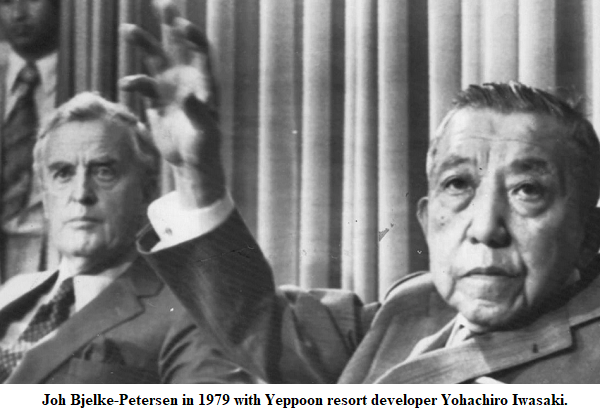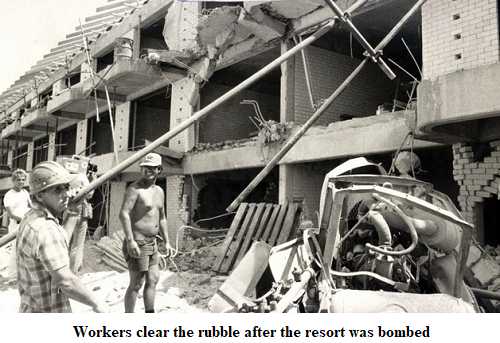
God has a sense of humour and every now and then he likes to play little games to show mere mortals how little they feature in the overall scheme of things. Non-believers can substitute Gaia or Mother Earth – sometimes things happen over which the best laid plans of mice and men (and women) have no control. Or maybe it’s just random: we roll the dice and fate decides which numbers come up. Sometimes we win, sometimes we lose and some days it would be better if we just stayed in bed.
Wednesday, June 20, 1979, was one of those days. If any of the detailed planning that went into that very controversial day at Farnborough, near Yeppoon in Central Queensland, included obtaining a weather prediction, then the Bureau of Meteorology forecasters should have been sacked on the spot. They should have screamed, “postpone or cancel!”
But the “Turning of the Soil” ceremony to mark a start on the Iwasaki Resort at an isolated bush site was the culmination of almost a decade of wrangling, frustration and changed concepts between the state government, Livingstone Shire Council and the inscrutable Japanese billionaire Yohachiro Iwasaki. Jumbo jets were flying into Australia from Japan and other international airports, dignitaries from all over Australia were also en route so, weather be damned, there was no turning back.
But God (or Gaia) decided to give us all a taste of what Noah had been forewarned when he started building the Ark. Mid-winter in Central Queensland normally meant mild temperatures and sunny blue skies, but the one day on the calendar which threw up a huge contrast in the form of relentless, driving rain, was the day the organisers chose.
It was a big event, not just for Yeppoon and Queensland, but for Australia. There was significant opposition from the RSL, fishermen and environmental groups as well as individuals who questioned why an overseas (Japanese) investor had been granted access and ownership of thousands of hectares of beautiful beachfront and pristine wetlands.
I could have assigned a reporter that day, but this was a primo excuse to get involved first-hand and that’s how I was a passenger, along with Murray the photographer, in a car driven by The Observer manager Len Sutherland who did his best not to get bogged in the quagmire that was once a bush track leading to the chosen site. The route was shared by taxis and shuttle buses ferrying passengers from Rockhampton Airport, many of whom had originally flown into Sydney on Jumbos which could not land at Rockhampton. Transferring to smaller domestic flights obviously presented a logistical nightmare but, as they say, the show must go on – and it did, despite the odds.
The site featured several large marquees housing a bevy of beautiful young female hostesses who were generously doling out copious quantities of traditional saki or whatever other liquor the drenched guests needed to raise their spirits. Domo arigato!
The official ceremony got underway on a large stage with a canvas canopy to fend off the deluge, and the risk of electrocution didn’t deter the speakers and interpreters – first old Yohachiro himself, then his ardent supporter, Premier Joh Bjelke-Petersen, followed by Deputy Prime Minister Doug Anthony and Japan’s ambassador, Yoshio Okawara.
I dutifully took notes while many of the guests wandered around with dazed looks, including many of the Japanese visitors who must have wondered why anyone would want to develop an international resort in such a God forsaken outpost of nothingness.
But then, after the drone of political platitudes, the ceremony included opening of saki casks and the distribution of traditional full wooden cups to the guests (some of us had already been sampling the bottled variety, thanks to the obliging Geisha girls!)
Joh and Yohachiro then left the stage to plant a couple of trees – one Japanese, one Australian – while I headed for the communications tent. I can’t remember the technicalities, or logistics; this was way before the eras of cell phones, but I was able to file a report of the proceedings back to The Observer office to make the next day’s front page. And I caught up with some old journo colleagues including Rob Strathdee, a former cadet at the Bundaberg News Mail who went on to become a Vietnam war correspondent and eventually editor of the Australian Associated Press wire service. Naturally, old Bundy boys found a bottle of Bundy’s best product to help ward off the elements. Then we settled back to enjoy the sumptuous feast and entertainment in the huge main marquee.
While we feasted, the Mileham Hayes Jazz Band played some cool tunes and then some traditional Japanese Taiko drummers warmed things up with their pounding rhythms to appease the rain gods. Eventually the proceedings wound down and the rain actually eased late in the afternoon, but by then I was as wet on the inside as I was on the outside. The stylish tan leather coat I wore was saturated and a side pocket never recovered its original shape after a bottle of saki stretched the wet leather like a mother kangaroo’s pouch before she evicted a fast-growing joey. Well, it was a day to remember. I was delivered back home to my wife Cathy and family by a grumpy Len, who told her I needed a good lecture when I sobered up, but he was probably just cranky that he couldn’t let his thin hair down as designated driver!
But resentment towards the project didn’t end there that day. According to media reports at the time, the land acquisition caused widespread outrage, given that Australian citizens and developers had been refused approval to buy the land on several occasions. There was also a belief that the deal involved kickbacks at Queensland government level.
Anti-Japanese sentiment surfaced, including fake money featuring a caricature of Mr Iwasaki with a stated value of ‘4 Grabs’, (or ‘up for grabs’). When construction began, the Yeppoon RSL club featured an anti-Japanese display on their lawns. The discontent literally exploded on November 29, 1980, the day of the Queensland election, when a bomb was set off at Iwasaki Resort. Two men were charged but later acquitted.

None of this stopped the project. Originally known as the Iwasaki Resort, it later became the Capricorn International Resort. Rydges managed the place until 2011, when the lease was taken over by Mercure.
But surprisingly, a new development proposal is now on the table, rivalling the original resort concept or one of many. Rydges managed the resort until 2011 and Accor until 2015, when it was returned to Iwasaki management. The current director of the company, Mr Iwasaki’s grandson, closed most of the facilities in 2016. Only the Japanese restaurant, one golf course and a wagyu cattle farm remained open. But in November 2013, the company reportedly submitted an initial advice statement to the Coordinator-General for a proposed $600 million redevelopment of the “Iwasaki Capricorn Integrated Resort”.
The project overview described a 300-room, five-star resort, golf course, caravan park, wagyu cattle farm, residential community of 8,000 dwellings, conservation precinct and airstrip. The 1,500-hectare development would create 8,500 jobs over 20 years of construction and 2,160 jobs when operational.
In December 2013, this was declared a coordinated project and an Environmental Impact Statement (EIS) was requested. The Coordinator-General has reportedly extended the EIS deadline six times. I wonder if old Yohachiro is looking down with an inscrutable smile, thinking of his original visions which never quite happened.
This is an excerpt from John Mikkelsen’s just-published memoir, ‘Don’t Call me Nev‘, which can be purchased via this link.
EDITOR’S ADDENDUM: Journalists are often accused of taking the Mixmaster to the facts at hand, the classic beat-up of newsroom lore in which cats become tigers and scratches mortal wounds. Well nobody can accuse John Mikkelsen of gilding truth’s lily; if anything he underplays the alcohol-sodden debacle of the ground-turning.
As it happens, I was covering the event for the Sun-Herald, having been picked up by a charter flight that originated in Melbourne and jetted north with what was quite likely Australian journalism’s greatest-ever cargo of freeloading junketeers.
The rain sheeted down and wouldn’t stop, leaving nothing better to do than jam cheek by thirsty jowl under inadequate canvas and, well, drink. Modern journalists of the university-trained kind would no doubt have stuck to mineral water, but these were old-schoolers and they didn’t stop. As not much more than a kid myself, what else could I do but learn from the elders?
At one point, I recall Dave Halpin, my older friend from the Sunday Telegraph (sadly in his grave these past 35 years), proclaiming in smug triumph that he had snapped “an up-close pic of Joh’s arse”, which he thought very amusing. So did I but, like almost everyone else, we were maggotted and it needs no great wit to get a giggle out of a drunk.
Another dim memory is of a local bloke, also drunk, alleging that Mr Iwasaki was a war criminal who should be “crucified like the Diggers in PNG.” After that, apart from Dave and I managing to ascend by mutual cooperation the runway stairs of the return flight, everything is a blur. I know I found a seat and, soaked to the skin, fell so deeply asleep that I missed the Sydney stop and slumbered on until woken by a concerned hostie in my native Melbourne.
I spent that night at Mum’s, where reservations about making a career in journalism were served with the breakfast bacon and eggs, after which I called my chief of staff in Sydney and told him, honestly, what had happened and why I wasn’t in the office. When the laughter stopped, he told me to grab the first flight back and, best of all, put the fare on my Fairfax expenses.
Ah, journalism! It ain’t what it used to be. Perhaps that is a good thing.
 Sign In
Sign In 0 Items (
0 Items ( Search
Search









I counted fifteen problematic passages in this article. Thank goodness that journalists are, in the main, more respectful, inclusive, non-racist and bland than hitherto.
I had first-hand experience of similar journalistic “events” during this period.
I must say that I prefer the journalists of that period – warts and all – to the effete hypocrites masquerading as journalist these days.
Reliable larrikins mostly.